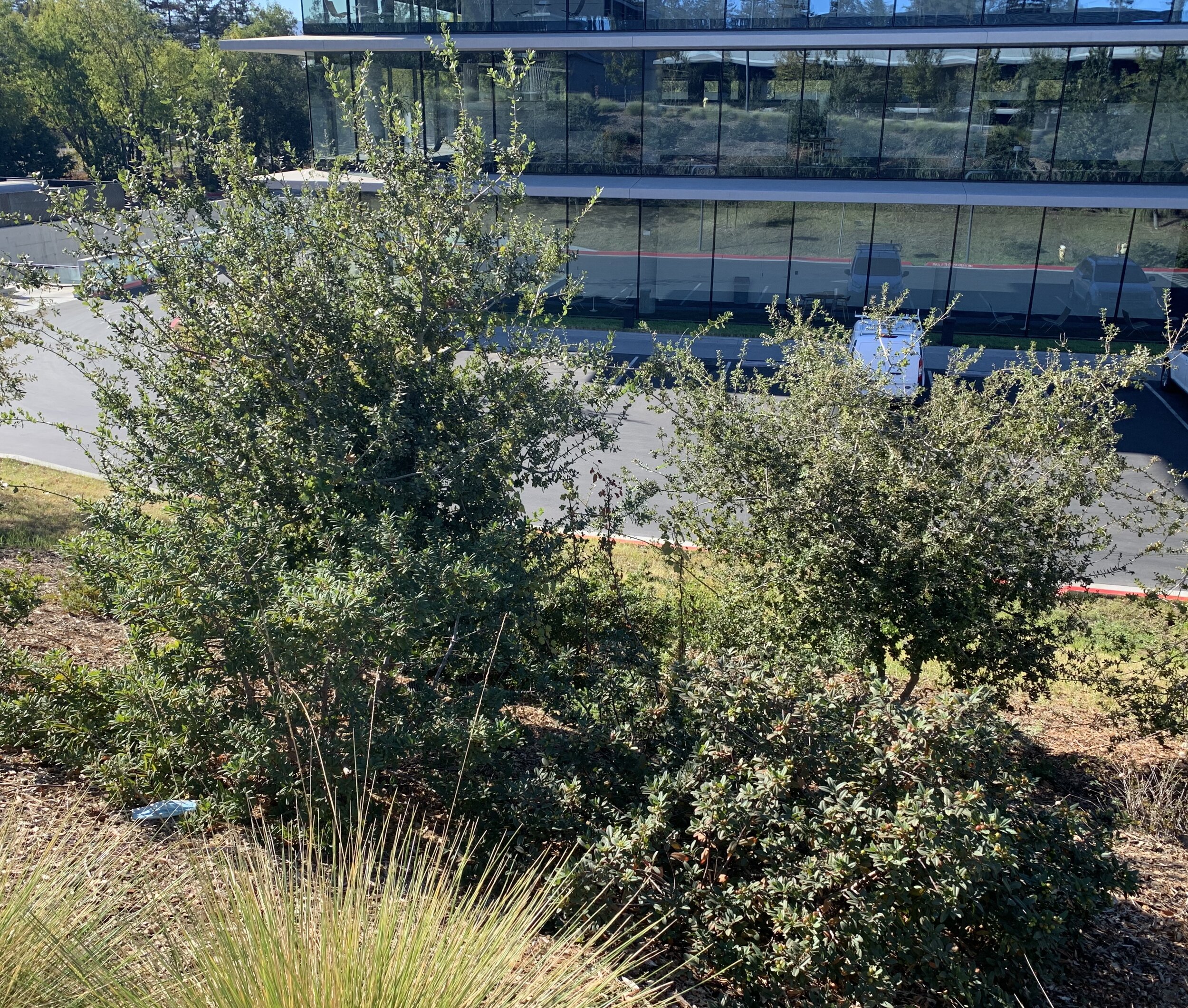Levantine Live Oak
Quercus calliprinos
Apple Park, Cupertino. Shields Oak Grove, UC Davis. Stanford University Campus. 101 Soundwall, East Palo Alto.
The oldest known Levantine live oaks (Quercus calliprinos) are in the Shields Oak Grove at the University of California, Davis, planted in the mid-1960's, and have grown to be a small to medium size evergreen trees. The leaves are small and oval, with short sharp teeth on the edge. The acorn cup also features many short, sharp teeth. From literally painful experience, any work on Levantine live oak, be it acorns picking or pruning, will likely yield blood, or at least deep scratches.
Let us take a brief evolutionary diversion, and consider why trees have evolved such armaments. The answer, of course, is animals. But we typically only see such spininess in arid adapted plants. So why are the arid plants armed for conflict? Because in arid environments, plants are typically widely spaced out, to be able to collect sufficient moisture to ensure survival. But being out there on their own exposes the arid adapted plants to other threats, in this case from animals.
In a moist forest, seeds are popping everywhere, and plant to plant competition drives the evolution and ecology. Trees is such places tend to have an upright, apically dominant growth habit, trying to overtop large numbers of competing plants. Close spacing, together with rapid growth, tend to combine to keep moist zone trees out of the way of potential animal predation.
Without the "safety in numbers" approach to protection found in moist environs, plants have to evolve individual protection from potential predators. Thus, spines as an impediment to animal predation. Which also tends to discourage humans from getting too close to the plants. But the spines occur in concert with other protective adaptations.
In moist environments, speed competition becomes a dominant plant strategy. But this is not an option in arid environments, where simply surviving on limited rainfall can be a huge challenge. So arid zone plants tend to grow as mounds or domes, spreading as much laterally as vertically, if not more so. In this way, predatory animals are pushed farther to the outside of the plant, allowing the top center of the plant to remain untouched.
In California wildlands where native oaks are allowed to grow on their own, this plant growth strategy is commonly seen. Oaks, especially the evergreen oaks which resemble Quercus calliprinos, often spend decades growing as shrubs, unrecognizable as trees. This phenomena is particularly common with Quercus chrysolepis, and regularly confuses oak hunters, especially because the juvenile foliage of Q. chrysolepis is very distinct from the mature foliage, and, in fact, looks like a totally different plant.
These young Q. chrysolepis often grow so low and wide they resemble groundcover. Except, invariably, after years or decades, one or more central stems will begin to rise from the middle of the plant. If the deer don't manage to nip these stems, they continue to grow, and begin to form the trunk of what will eventually become a mature Q. chrysolepis.
Now, returning to Quercus calliprinos, we have some understanding of the spininess of the species, and why it grows more like a giant shrub than a tree.
Experimentation with Q. calliprinos outside the Shields Grove has yielded very mixed results. The trees are extremely sensitive to soil drainage, showing their displeasure through poor growth, chlorosis and root diseases. They grow best on arid sites with well drained soils, though they do grow very slowly. Currently there are a few dozen 15 year old Q. calliprinos scattered around the Stanford Arboretum, and although they established themselves with no supplemental irrigation, they remain quite small.
But, invariably, there are a few hybrids which have appeared in the experiments. In the Shields Grove, there is a closely related Asian evergreen oak, Quercus phillyreoides, growing near to the Q. calliprinos. They hybridize, and such hybrids can be found at Stanford, and at Apple Park. In fact, at Apple Park, the true species Q. calliprinos are struggling with soil drainage and irrigation issues, while the Q. calliprinos x phillyreoides hybrids are thriving. These highly unique hybrids spontaneously appear from Q. calliprinos acorns that received Q. phillyreoides pollen. Because one parent is highly drought adapted, while the other tolerates copious precipitation, the offspring show a truly wide range of adaptation. This is a great example of positive hybridization, and more of these hybrids should be captured and tested.
As for true species Quercus calliprinos, there is somewhat limited utility in ornamental urban California. The general unfriendliness of this well-armed tree, combined with its intolerance of dry season irrigation, limits its ornamental usefulness. But, as one of the most drought adapted trees in the world, Q. calliprinos does have tremendous potential utility for carbon sequestration tree plantings in very dry and harsh environments throughout California. Quercus calliprinos may yet find its place in a climate changed California.
Learn More:
-

iNaturalist
See and learn about the tree in the wild…
-

Oaks of the World
Learn all about this tree…
-

The Israel Oak Registry
Species ID and more…
-

SelecTree
A tree selection guide























